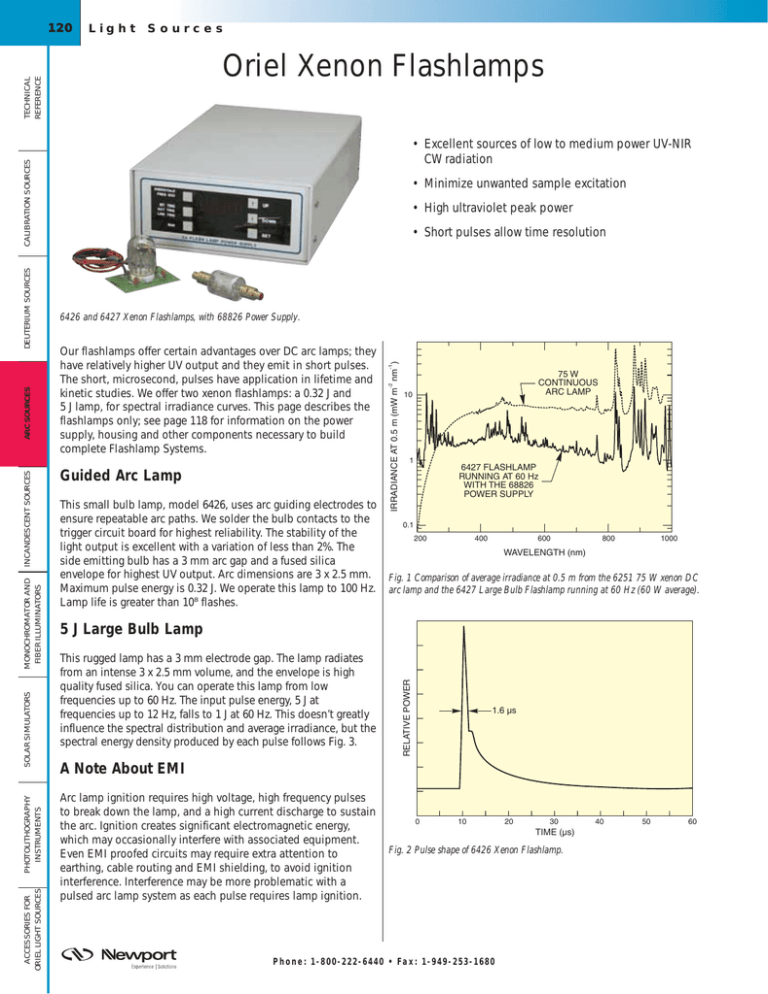Oriel Xenon Flashlamps
advertisement

120 Light Sources TECHNICAL REFERENCE Oriel Xenon Flashlamps ACCESSORIES FOR ORIEL LIGHT SOURCES PHOTOLITHOGRAPHY INSTRUMENTS • Minimize unwanted sample excitation • High ultraviolet peak power • Short pulses allow time resolution Guided Arc Lamp This small bulb lamp, model 6426, uses arc guiding electrodes to ensure repeatable arc paths. We solder the bulb contacts to the trigger circuit board for highest reliability. The stability of the light output is excellent with a variation of less than 2%. The side emitting bulb has a 3 mm arc gap and a fused silica envelope for highest UV output. Arc dimensions are 3 x 2.5 mm. Maximum pulse energy is 0.32 J. We operate this lamp to 100 Hz. Lamp life is greater than 108 flashes. -1 75 W CONTINUOUS ARC LAMP -2 Our flashlamps offer certain advantages over DC arc lamps; they have relatively higher UV output and they emit in short pulses. The short, microsecond, pulses have application in lifetime and kinetic studies. We offer two xenon flashlamps: a 0.32 J and 5 J lamp, for spectral irradiance curves. This page describes the flashlamps only; see page 118 for information on the power supply, housing and other components necessary to build complete Flashlamp Systems. IRRADIANCE AT 0.5 m (mW m nm ) 6426 and 6427 Xenon Flashlamps, with 68826 Power Supply. 10 1 6427 FLASHLAMP RUNNING AT 60 Hz WITH THE 68826 POWER SUPPLY 0.1 200 400 600 800 1000 WAVELENGTH (nm) Fig. 1 Comparison of average irradiance at 0.5 m from the 6251 75 W xenon DC arc lamp and the 6427 Large Bulb Flashlamp running at 60 Hz (60 W average). 5 J Large Bulb Lamp This rugged lamp has a 3 mm electrode gap. The lamp radiates from an intense 3 x 2.5 mm volume, and the envelope is high quality fused silica. You can operate this lamp from low frequencies up to 60 Hz. The input pulse energy, 5 J at frequencies up to 12 Hz, falls to 1 J at 60 Hz. This doesn’t greatly influence the spectral distribution and average irradiance, but the spectral energy density produced by each pulse follows Fig. 3. RELATIVE POWER SOLAR SIMULATORS MONOCHROMATOR AND FIBER ILLUMINATORS INCANDESCENT SOURCES ARC SOURCES DEUTERIUM SOURCES CALIBRATION SOURCES • Excellent sources of low to medium power UV-NIR CW radiation 1.6 µs A Note About EMI Arc lamp ignition requires high voltage, high frequency pulses to break down the lamp, and a high current discharge to sustain the arc. Ignition creates significant electromagnetic energy, which may occasionally interfere with associated equipment. Even EMI proofed circuits may require extra attention to earthing, cable routing and EMI shielding, to avoid ignition interference. Interference may be more problematic with a pulsed arc lamp system as each pulse requires lamp ignition. 0 10 20 30 TIME (µs) Fig. 2 Pulse shape of 6426 Xenon Flashlamp. Phone: 1-800-222-6440 • Fax: 1-949-253-1680 40 50 60 Light Sources 121 TECHNICAL REFERENCE 1.13 6426 0.32 J GUIDED Xe (29) 0.12 (3) 2.0 9 µs 1.18 (51) (30) 1.88 (48) 1.5 (38) 0.25 (6.3) 2.1 CALIBRATION SOURCES RELATIVE POWER ARC GAP (54) 10 20 30 40 50 60 DEUTERIUM SOURCES 2.4 0 (61) 70 TIME (µs) Fig. 3 Pulse shape of 6427 Xenon Flashlamp. 6427 5J LARGE BULB Xe 0.98 (25) 3.25 ARC SOURCES (83) 0.12 (3) 1.63 ARC GAP (41) INCANDESCENT SOURCES 0.33 (8.3) Fig. 4 Dimensional diagram of Xenon Flashlamps. Ordering Information Lamp Type Effective Arc Size Max Energy (J) Max Power (W) Pulsewidth Max Repetition Rate 6426 0.32 J Xe Guided Arc 3 x 2.5 mm 0.32 J 16 W 1.6 µs 100 Hz 6427 5 J Xe Large Bulb 3 x 2.5 mm 5J 60 W 9 µs 60 Hz WEB See our website for more info MONOCHROMATOR AND FIBER ILLUMINATORS Model SOLAR SIMULATORS PHOTOLITHOGRAPHY INSTRUMENTS ACCESSORIES FOR ORIEL LIGHT SOURCES Email: sales@newport.com • Web: newport.com

